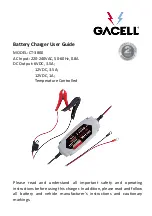
16-8
Charging System
ENGINE ELECTRICAL
Engine (Non-turbo)>
This test determines if the generator output current
is normal.
Before testing, be sure to check the following:
l
Generator installation and wiring connec-
tions
l
Battery (Refer to GROUP 54 Battery.)
NOTE
The battery used should be slightly discharged.
The load needed by a fully-charged battery
is insufficient for an accurate test.
l
Generator drive belt tension (Refer to
GROUP 00 Maintenance Service.)
l
Fusible link
l
Abnormal noise from the generator while
the engine is running
Turn the ignition switch to the OFF position.
Disconnect the negative battery cable.
Disconnect the generator output wire from the
generator
terminal. Connect a DC test am-
meter with a range of
A in series between
the
terminal and the disconnected output
wire. (Connect the
lead of the ammeter
to the
terminal. Connect the
lead of
the ammeter to the disconnected output wire.)
Caution
Never use clips but tighten bolts and nuts
to connect the line. Otherwise loose connec-
tions (e.g. using clips) will lead to a serious
accident because of high current.
NOTE
An inductive-type ammeter which enables mea-
surements to be taken without disconnecting
the generator output wire is recommended.
Connect a voltmeter with a range of
between the generator
terminal and the
ground. (Connect the
lead of the voltmeter
to the
terminal, and then connect the
lead of the voltmeter to the ground.)
Connect the negative battery cable.
Leave the hood open.
Check that the reading on the voltmeter is equal
to battery voltage.
NOTE
If the voltage is 0 the cause is probably
TSB Revision
an open circuit in the
fusible link between
the generator “B” terminal and the battery
terminal.
(9) Start the engine, and turn the headlights on.
the
to high beam, turn the
heater blower switch to High, increase the en-
gine speed to approx.
and read
the maximum. current output displayed on the
ammeter.
Limit: 70% of nominal
current
NOTE
For the nominal current output, refer to the
G e n e r a t o r
Because the current from the battery will
soon drop after the engine is started,
(10) should be carried
as possible in order to obtain the maximum
current output” value,
The current output’ value will
the electrical load and the temperature of
the generator body.
If insufficient electrical load is used while
testing, the specified level of current may
not be output even though the generator
is normal.
In such cases, increase the
electrical load by leaving the headlights
on with the engine off to discharge the bat-
tery before testing.
The specified level of current also may not
be output if the temperature of the genera-
tor body and/or ambient temperature is too
high. In such cases, allow the generator
to cool before testing.
reading on the ammeter should be above
the limit value.
If the reading ‘is below the
limit value ‘and the generator output wire is
normal, replace the generator.
the engine at idle speed after the test.
the ignition switch to the OFF position.
the negative battery cable.
the ammeter and voltmeter.
the generator output wire to the gener-
ator
terminal.
the negative battery cable.
Summary of Contents for Eclipse 1997
Page 2: ... _i _a i 20 _ 1 ...
Page 3: ... i G _ i ...
Page 14: ...12 NOTES d i ...
Page 20: ...COMPONENT LOCATIONS Grounding i I A16XO766 I A16XO776 TSB Revision ...
Page 21: ..._ _ TSB Reyision ...
Page 29: ...COMPONENT LOCA IONS Sensor 2 0L Engine Non turbo Bl6XO6SZ I ...
Page 31: ...COMPONENT LOCATIONS T Sensor 2 0L Engine vurbo i TSB Revision __ AlSX1350 I ...
Page 32: ...30 COMPONENT LOCATIONS Sensor 2 0L Engine flurbg AlSXO617 I TSB Revision ...
Page 33: ...COMPONENT OCATIONS Sensor x2 4L Ehgfne 44 16X1245 00005366 I TSB Revision ...
Page 34: ...ssure sensor 32 COMPONENT LOCATIONS Sensor 2 4L Epghe 1 _ C16Xll85 AlSXOBBO 1 TSB Revision ...
Page 35: ...COMPONENT LOCATIONS Fensor e2 4L E gine Y _ TSB Revision ...
Page 37: ...Al6X1165 Automatic compressor ECM AlIXO616 TSB Revision I ...
Page 38: ...36 COMPONENT LdCATlQNS Control Unit Pi 9 TSB Revision ...
Page 41: ...COMPONENT LOCATIONS Solenoid and Solenoid Valve with built in solenoid valve I TSB Revision ...
Page 46: ...44 I a NOTES va Il II c ...
Page 72: ...70 NOTES ...
Page 75: ...CI RCWIT DIAGRAMS II p NOTES ...
Page 80: ...CIRCUIT DIAGRAMS How to Read Circuit Diaaiahis TSB Revision ...
Page 119: ...I _ i ...
Page 129: ... _ I I I ...
Page 161: ... I I CIR CUIT D I A G R A M S 1 c a ...
Page 171: ...G k L L 4 a I F 28 l I G W _ TSB Revision ...
Page 173: ......
Page 179: ...II ...
Page 183: ... i I ...
Page 199: ......
Page 207: ...NOTES I ...
Page 213: ... k __ _ _ _ __ __ B l R B 1 R B J B 2 1 LINK CONNECl B 1J C l 0 ...
Page 241: ...ciRcun DIAGRAMS NOTES ...
Page 247: ... I I I A _ i r ...
Page 257: ... ...
Page 271: ...CIRCUIT DIAQRAMS 1 I I 269 ...
Page 278: ...CIRCUIT DIAGRAMS 5 277 I _ I _I _ _ ...
Page 282: ...CtRWtT D I A G R A M S A f sr NOTES i f s I c 1 I ...
Page 292: ...NOTES p I ...
Page 298: ... I ...
Page 304: ...QRCUIT D I A G R A M S fg NOTES 7 ...
Page 328: ......
Page 338: ...SLIDE 1 I 1 25Y W 1 25G Y ECLIPSE j I POWER SEAT ASSEMBLY E 45 _I j _ TSB Revision ...
















































